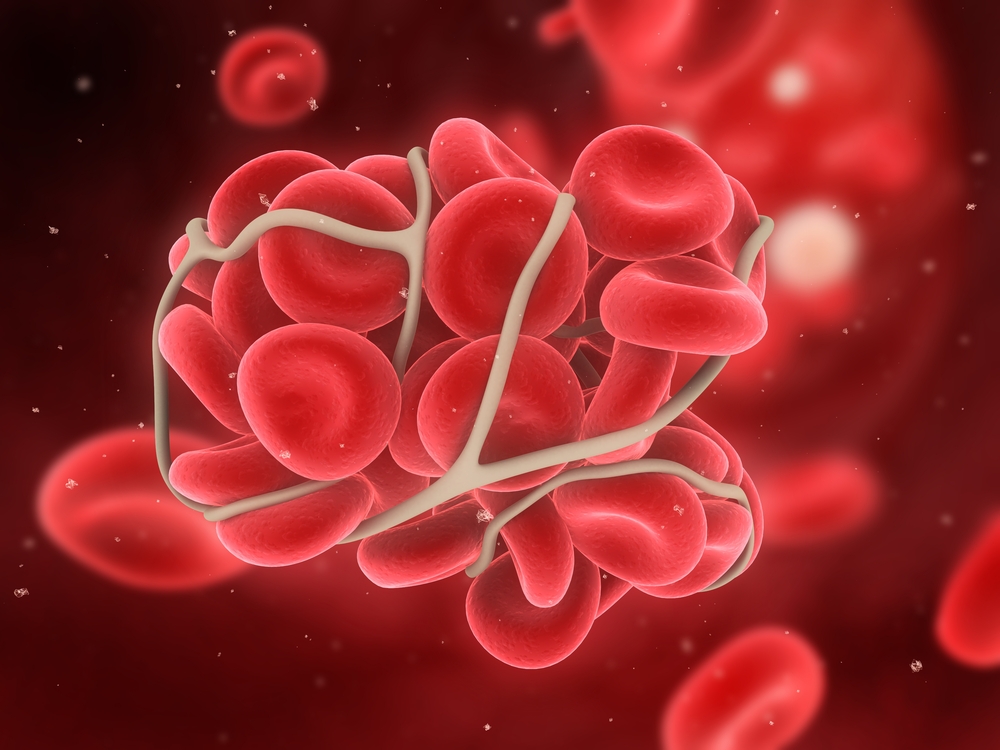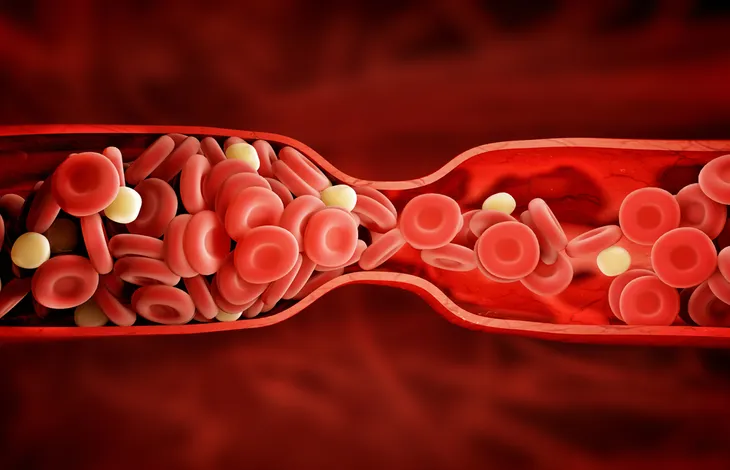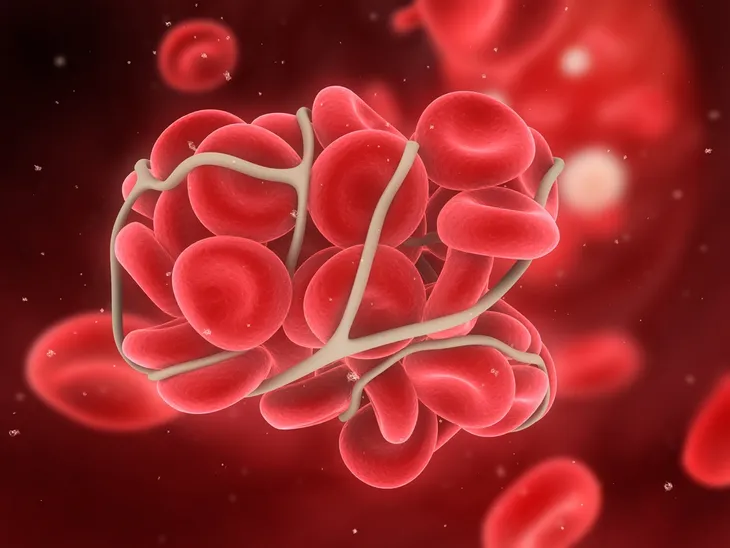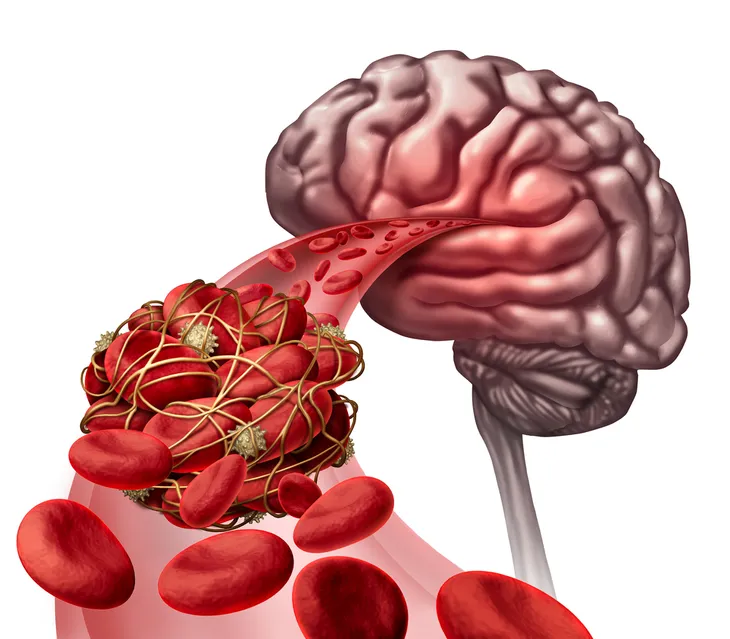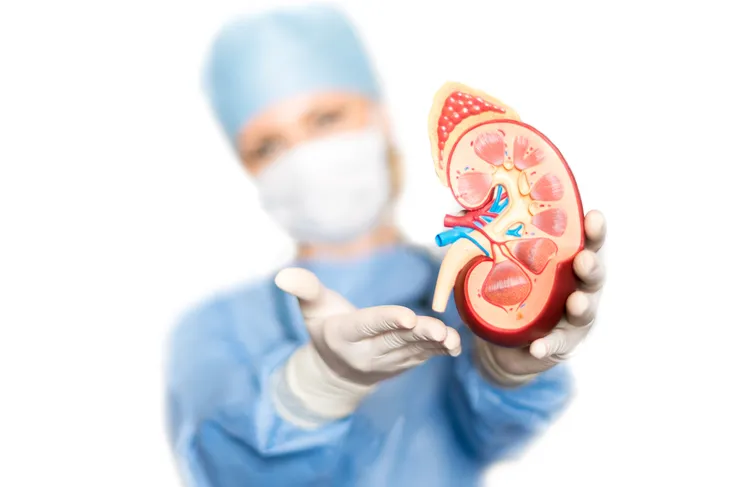Blood clots could be hiding in your body and lead to serious complications and even death, but how would you know if you have one? Turns out there are some symptoms depending on where the blood clot is, so you’ll know when to take action.
Blood clots often fall apart on their own, but when they don’t, they can block oxygen flow and lead to conditions such as heart attacks and strokes. It’s important to know the signs before it gets to that point, so let’s take a deeper look at 12 signs of a blood clot…
Defining a Blood Clot
Before you can combat against blood clots, it helps to understand exactly what they are. While blood clots are healthy when they’re stopping the blood flow from a cut or injury, they can also form when they’re not actually needed, which can be a real problem, notes WebMD.
Platelets in your blood are activated by damage to a blood vessel, “changing shape to form a plug that fills in the broken part to stop blood from leaking out,” notes the source. Chemicals from the platelets further the clotting process by attracting other platelets, and then proteins in your blood (called clotting factors) end up as long strands of fibrin that get “tangled up with the platelets in the plug to create a net that traps even more platelets and cells,” it adds. There are usually other proteins to break down the clot, but cholesterol buildup (plaques) can also trigger a clot when they break open.
More Than One Type of Clot
There are different types of blood clots depending on where they occur in your system, adds WebMD. While different areas of your body can be affected by clots, there are generally two types: arterial and venous, adds the source.
It explains that arterial clots block blood (and oxygen) from reaching vital organs, which can lead to tissue damage. They may also form in the heart or brain, setting off a heart attack or stroke. Meanwhile, venous clots in veins “tend to develop slowly.” Therefore, the symptoms may not be as obvious. There are different types of clots in the venous category – superficial venous thrombosis (near the surface), deep vein thrombosis (DVT), and pulmonary embolism (PE). We’ll look more at those next.
Going Deeper About Thrombosis
The Mayo Clinic explains that DVT occurs in a “deep vein” in your body, most often in the legs. This can set off some telltale signs in the legs, or you might not suspect anything at all.
DVT can also occur if you have certain medical conditions affecting the clotting of your blood. “It can also happen if you don’t move for a long time, such as after surgery or an accident, or when you’re confined to bed,” adds the clinic.
Symptoms By Region: Arms and Legs
The American Heart Association says a blood clot deep in the leg can cause symptoms of pain, redness, warmth, and swelling in the lower part of the leg, which could indicate DVT. If the blood clot is in your arm, you’ll have the same signs in the affected arm, adds the source. Other sources note an arterial clot in the arm or leg can cause paleness and even coolness to the touch.
Another condition that can cause similar symptoms in the leg is peripheral artery disease (PAD), which can come and go depending on whether you’re exercising, adds the source. It’s important for a doctor to sort this out.
Symptoms By Region: Heart
WebMD looks at the signs and symptoms of blood clots depending on which major organ they affect. It notes that clots that “form in or around your ticker” can cause a heart attack, which is obviously a medical emergency.
The source warns to look out for signs such as severe pain in your chest or arms, (unexplained) sweating, or trouble breathing. These signs can also be present on their own and indicate another problem, but it’s best not to leave it to chance if you’re experiencing these on their own or in combination.
Symptoms By Region: Lungs
The American Heart Association says that blood clot symptoms for the lungs can be similar to those relating to the heart. Clots near the lungs (usually ones that have traveled from another area of the body) can cause the telltale chest pain and shortness of breath related to a heart attack, as well as discomfort that spreads into the arms, back, neck, or jaw.
However, these symptoms could also indicate a pulmonary embolism, which are potentially deadly clots in the lungs, says the same source. It adds that there could be another symptom related to lung blood clots that other types might not share: sudden fainting.
Symptoms By Region: Abdomen
Blood clots can form in your abdominal region, and they could at first lead you to believe you have severe gas or even food poisoning. RadiologyInfo.org explains clots in the middle section of your body around your belly can cause severe abdominal pain, nausea, and vomiting.
You may also experience diarrhea and blood in the stool from this type of blood clot, adds the source. However, keep in mind bloody stools can also be a warning sign of colorectal cancer, so a trip to the doctor is warranted in either scenario.
Symptoms By Region: Brain
Blood clots in the brain may be the most infamous of the clots, as they can lead to a stroke. Strokes can be minor (transient ischemic attack) if the blood clot breaks up, but they can also lead to permanent damage and major complications.
There are several telltale signs of a stroke depending on where the clot is in the brain, but Heathline.com notes “a sudden and severe headache,” as well as sudden difficulty with vision or speaking can be symptoms. Weakness on one side of the body is also a common sign of a stroke.
Symptoms By Region: Kidneys
This particular clot affecting the kidneys is referred to as renal vein thrombosis (RVT), explains Healthline.com. The renal veins are responsible for leading oxygen-depleted blood away from the kidneys, and this condition can cause serious, life-threatening damage.
Detecting RVT may be more difficult than some other clot-related signs, but the source says symptoms can include decreased urine volume, lower back pain, and blood in the urine. This type of clot can break up and end up in the lungs, which will cause chest pain “that worsens with every breath,” it adds.
Risk Factors for Blood Clots
How does a person end up with a blood clot? While there’s no foolproof way to avoid them altogether, there are certain factors that put you in a higher risk bracket, explains Healthline.com.
One of the factors includes a recent extended hospital stay that could be related to major surgery, says the source. Other risk factors, some of which can’t be controlled, include age (65 and older), lengthy travel of four or more hours at a time, obesity, pregnancy, family history, smoking, cancer, and even some birth control pills, adds the source.
What You Can Do
While quitting smoking and getting your weight under control are two ways to help reduce the chance of developing a blood clot, there are other things you can do every day to stave off a clot, explains the Agency for Healthcare Research and Quality (AHRQ).
These practices include wearing loose-fitting clothing (including socks and stockings), raising your legs above your heart periodically, changing positions often during a long trip, cutting down on sodium, and performing doctor-prescribed exercises, offers the source.
When It’s Time to Call a Doctor
You might not be able to tell if you have a blood clot from the symptom mentioned alone. In fact, Healthline notes up to 50-percent of people with DVT, in particular, don’t know it, and you may not have time to think about it when complications arise.
If you have sudden symptoms of shortness of breath, chest pressure, or difficulty with sight or speaking, then it’s time to call for emergency medical help, says the source. At the least, a physician can rule out a blood clot or determine what’s causing the symptoms by sending you for tests or provide more immediate help in the case of stroke or heart attack.
